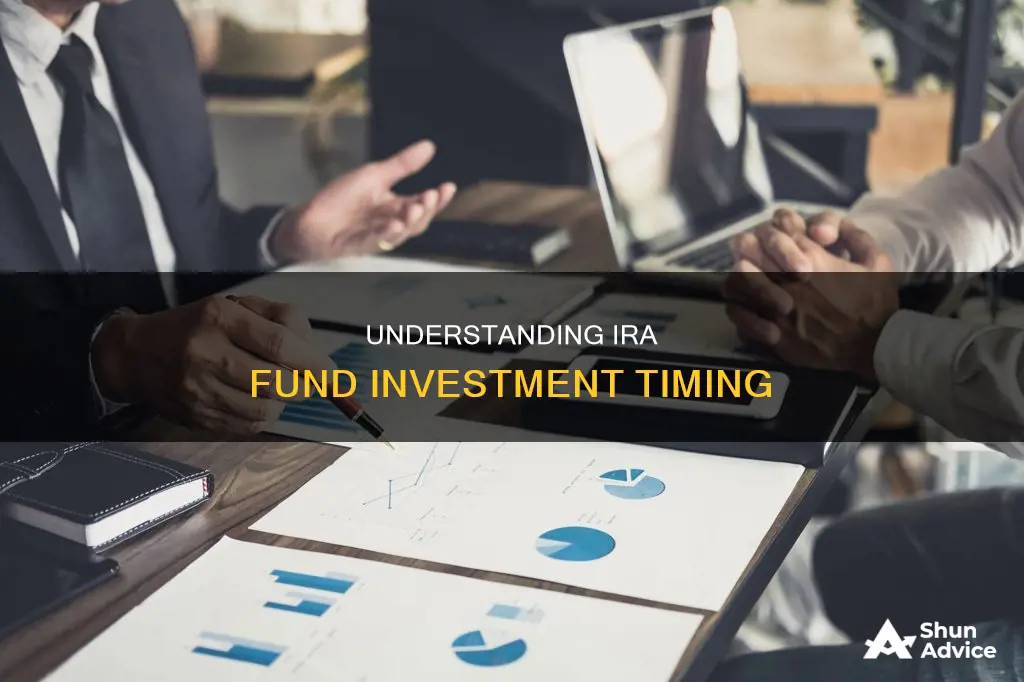
An Individual Retirement Account (IRA) is a long-term, tax-advantaged savings account that individuals with earned income can use to save for the future. IRAs are designed primarily for self-employed people who do not have access to workplace retirement accounts, but anyone with earned income can open and contribute to an IRA. IRAs are meant to be used to invest and maximize the growth of funds for retirement savings. There are several types of IRAs, including traditional IRAs, Roth IRAs, Simplified Employee Pension (SEP) IRAs, and Savings Incentive Match Plan for Employees (SIMPLE) IRAs. The best IRA accounts offer a wide range of investment options, including stocks, bonds, mutual funds, exchange-traded funds (ETFs), and even real estate. When choosing investments for your IRA, it's important to consider your risk tolerance, time horizon, and financial goals.
| Characteristics | Values |
|---|---|
| Investment options | Individual stocks, mutual funds, exchange-traded funds (ETFs), real estate investment trusts (REITs), robo-advisors, target-date funds |
| Investment strategy | Asset allocation, risk tolerance, diversification, dollar-cost averaging |
| Types of IRAs | Traditional, Roth, Simplified Employee Pension (SEP), Savings Incentive Match Plan for Employees (SIMPLE) |
| Tax advantages | Tax-deductible contributions, tax-free withdrawals, tax-deferred growth |
| Early withdrawal penalty | 10% of the amount withdrawn before age 59½, plus taxes |
| Annual contribution limit | $7,000 for individuals under 50, $8,000 for individuals 50 and older |
| Income limitations | Vary based on filing status, income, and retirement plan coverage through an employer |
| Required minimum distributions (RMDs) | Begin at age 73 for traditional IRAs and 401(k)s |
What You'll Learn

Understanding asset allocation
When deciding on your asset allocation, it's crucial to consider your risk tolerance and investment timeframe. A common rule of thumb is to subtract your age from 100 or 110 to determine the percentage of your portfolio allocated to stocks. For instance, if you're 30 years old, 70-80% of your portfolio should be in stocks. However, as you approach retirement, it's generally advisable to reduce your stock allocation and increase investments in bonds and short-term investments to lower the overall risk.
Additionally, your financial situation can also impact your asset allocation. If you have a long-term goal, such as retirement in 20 years, you may be able to tolerate more risk in your retirement account compared to a short-term bill-paying account.
To effectively manage your asset allocation, you can consider using mutual funds or exchange-traded funds (ETFs). These investment options provide diversification by allowing you to invest in a basket of securities rather than individual stocks. You can allocate more of your equity portfolio to large-cap or total stock market funds and less to small- and mid-cap funds. Similarly, you can allocate most of your bond investments to a total U.S. bond market fund and a smaller amount to an international bond fund.
Mutual Fund Strategies: Long-Term Investments for Financial Freedom
You may want to see also

Risk tolerance
- Age: Generally, younger investors are perceived to have a higher risk tolerance than older individuals. This is because they have a longer time horizon for their investments to recover from potential losses. However, it's important to note that age is not the sole determining factor, and individuals should assess their specific circumstances.
- Investment Goals: Your investment objectives play a significant role in determining your risk tolerance. If you are investing for retirement or other long-term financial goals, you may be able to tolerate more risk. In contrast, if you are saving for shorter-term goals or need access to your funds soon, a more conservative approach may be preferable.
- Income and Net Worth: Individuals with higher incomes or net worth may have greater risk tolerance because they can afford to take on more risk without jeopardizing their financial stability. Conversely, those with limited financial resources may need to be more cautious.
- Investment Experience: Your level of investment experience can influence your risk tolerance. If you are new to investing, you may want to start with a more conservative approach until you gain more knowledge and confidence.
- Risk Capacity: While risk tolerance measures your willingness to take risks, risk capacity assesses your financial ability to take on risk. It's important to align your risk tolerance with your risk capacity to make informed investment decisions.
When investing your IRA funds, it's crucial to strike a balance between taking on sufficient risk to achieve your financial goals and maintaining a level of comfort with the potential volatility of your investments. Remember, investing involves risk, and it's important to carefully consider your risk tolerance before making any investment decisions.
Vanguard Funds: Best Investment Options for Your Portfolio
You may want to see also

Mutual funds
When considering mutual funds for your IRA, it is important to understand the differences between traditional IRAs and Roth IRAs. Traditional IRAs offer tax-deductible contributions, while Roth IRAs do not. Withdrawals from traditional IRAs are typically taxed as ordinary income, whereas withdrawals from Roth IRAs are tax-free if certain conditions are met. Additionally, traditional IRAs require mandatory distributions starting at age 73, whereas Roth IRAs do not have this requirement.
There are also different types of mutual funds to consider, such as equity funds, fixed-income funds, money market funds, and hybrid funds. Each type has its own characteristics and risk profile. It is important to evaluate these options based on your financial goals, risk tolerance, and investment horizon.
Furthermore, mutual funds can be actively or passively managed. Actively managed funds have fund managers who actively make investment decisions, while passively managed funds track specific benchmarks. Actively managed funds tend to have higher fees due to the more hands-on management approach.
When investing in mutual funds through an IRA, it is important to consider the fees and expenses associated with the funds. Mutual funds may have sales loads, upfront fees, or redemption fees. Additionally, there may be brokerage commissions and fees for buy and sell orders within the IRA. These costs can impact the overall returns of your investment.
In summary, mutual funds are a popular choice for IRA investments due to their diversification and professional management. When considering mutual funds for your IRA, it is important to understand the different types of IRAs, mutual funds, and the associated fees and expenses. Always evaluate your financial goals, risk tolerance, and investment horizon before making any investment decisions.
Gold Fund Investment: Timing is Everything
You may want to see also

Investment fees
Understand the Types of Investment Fees
Firstly, it's important to know the types of fees associated with your IRA. These can include set-up fees, annual fees, custodial and account maintenance fees, transaction fees, and commissions. Additionally, there are financial advisor fees, investment advisory fees, investment management fees, and legal and tax advice fees related to your investments. Safe deposit box fees may also apply.
Pay Fees with Retirement Funds or Personal Funds?
You can choose to pay IRA fees using your retirement account or personal funding. Paying with your retirement account is advantageous as the amount paid is not taxable since it's considered an expense. However, using personal funding allows you to keep your IRA balance intact and maximise tax-deferred growth. The best approach depends on your financial situation and saving strategy.
Minimise Investment Fees
When choosing an IRA provider, look for competitive commissions and abundant low-cost investment options. Robo-advisors, for example, offer low-cost portfolio management services. Additionally, consider using a self-directed IRA, which provides access to a broader selection of investments, including real estate and commodities.
Deductibility of Investment Fees
While some IRA management fees were previously tax-deductible, they are not deductible for the 2023 tax year due to the Tax Cuts and Jobs Act. However, this provision expires after the 2025 tax year unless it is extended. It's important to consult a tax professional for personalised advice as individual circumstances vary, and some states may have different rules.
ETFs and Mutual Funds: Key Investment Considerations
You may want to see also

Investment types
Low-Risk Investments
- Savings accounts: These are the safest and most liquid investments after cash. While they offer very low interest rates, your money is protected by the Federal Deposit Insurance Corporation (FDIC).
- Certificates of Deposit (CDs): CDs are considered very safe, and your money is protected by the FDIC up to $250,000. You usually need to keep your money in a CD for a set period, ranging from three months to several years, and they typically offer higher interest rates than savings accounts.
- Treasury Bills and US Savings Bonds: US Treasury bills are considered the world standard for liquidity and safety, but they are expensive to purchase individually. US savings bonds are also low-risk and are backed by the full financial strength of the US government, but they are not FDIC-insured.
- Money Market Funds and Accounts: These are very low-risk and invest in secure assets like cash and cash equivalents, CDs, and US Treasuries. Money market accounts often come with check-writing privileges and a debit card, and they tend to offer higher interest rates than savings accounts.
Higher-Risk Investments
- Mutual Funds: Mutual funds are a common choice for IRAs because they offer broad diversification. Actively managed mutual funds pool investor capital and hire professional managers to invest in stocks, bonds, and other assets. There are also index funds, which are passively managed and aim to replicate the performance of a stock market index.
- Exchange-Traded Funds (ETFs): ETFs are similar to index funds but trade like stocks, so they can be bought and sold throughout the trading day. They can track an underlying index, commodity, sector, or other assets.
- Stocks: Also known as equities, stocks are high-risk and require research. They represent ownership of a fraction of a company and can be bought and sold on stock exchanges. If the company issues dividends, investors may be eligible for a portion of the earnings. Stocks may also increase in value, allowing investors to sell for a profit.
- Bonds: A bond is a debt obligation that matures on a certain date. Corporate bonds, for example, represent a loan made by the investor to a corporation, and they pay interest at a stipulated rate. Bonds are traded worldwide, and it is possible to lose money when investing in them.
Other, more sophisticated investment options for IRAs include rental real estate, precious metals, and private placements.
Large-Cap Funds: When to Invest for Maximum Returns
You may want to see also
Frequently asked questions
You can open an IRA through a bank, an investment company, an online brokerage, or a personal broker.
Types of IRAs include traditional IRAs, Roth IRAs, Simplified Employee Pension (SEP) IRAs, and Savings Incentive Match Plan for Employees (SIMPLE) IRAs.
Broad-based stock and bond index funds are good starting points for an IRA. A few core index funds, including exchange-traded funds (ETFs) and conventional mutual funds, should be enough to meet most investors' diversification needs at a minimal cost.







